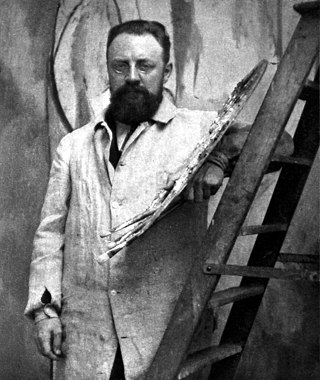
Henri Émile Benoît Matisse was a French visual artist, known for both his use of colour and his fluid and original draughtsmanship. He was a draughtsman, printmaker, and sculptor, but is known primarily as a painter.

The Menil Collection, located in Houston, Texas, refers either to a museum that houses the art collection of founders John de Menil and Dominique de Menil, or to the collection itself of paintings, sculptures, prints, drawings, photographs and rare books.
Events from the year 1952 in art.
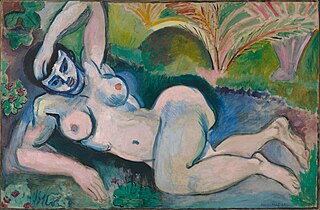
Blue Nude (Souvenir of Biskra) (French: "Nu bleu, Souvenir de Biskra"), an early 1907 oil painting on canvas by Henri Matisse, is located at the Baltimore Museum of Art as part of the Cone Collection.

Dominique de Menil was a French-American art collector, philanthropist, founder of the Menil Collection and an heiress to the Schlumberger Limited oil-equipment fortune. She was awarded the National Medal of Arts in 1986.

Dance (La Danse) is a painting made by Henri Matisse in 1910, at the request of Russian businessman and art collector Sergei Shchukin, who bequeathed the large decorative panel to the Hermitage Museum, in Saint Petersburg. The composition of dancing figures is commonly recognized as "a key point of (Matisse's) career and in the development of modern painting". A preliminary version of the work, sketched by Matisse in 1909 as a study for the work, resides at MoMA in New York, where it has been labeled Dance (I).
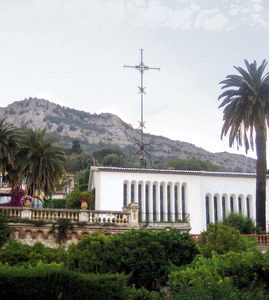
The Chapelle du Rosaire de Vence, often referred to as the Matisse Chapel or the Vence Chapel, is a small Catholic chapel located in the town of Vence on the French Riviera. It was dedicated to the Dominican Order. The church was built and decorated between 1947 and 1951 under a plan devised by the artist Henri Matisse.

The Blue Nudes is a series of collages, and related color lithographs, by Henri Matisse, made from paper cut-outs depicting nude figures in various positions. Restricted by his physical condition after his surgery for stomach cancer, Matisse began creating art by cutting and painting sheets of paper by hand; these Matisse viewed as independent artworks in their own right. The Blue Nudes refers also to the editioned multiples based on the cut-outs. Matisse supervised the creation of these lithographs until his death in 1954.

The Painter and His Model is a work by Henri Matisse painted late 1916, early 1917. It is currently in the collection of the Musée National d'Art Moderne, Centre Georges Pompidou, Paris. In this work Matisse depicted himself in his studio on the fourth floor of 19 Quai Saint-Michel, at work on his painting Laurette in a Green Robe (1916).
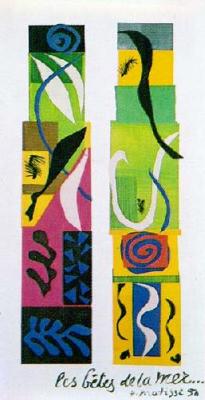
Beasts of the Sea is a paper collage on canvas by Henri Matisse from 1950. It is currently in the collection of the National Gallery of Art, Washington, D.C. During the early-to-mid-1940s Matisse was in poor health. Eventually by 1950 he stopped painting in favor of his paper cutouts. Beasts of the Sea, is an example of Matisse's final body of works known as the cutouts.
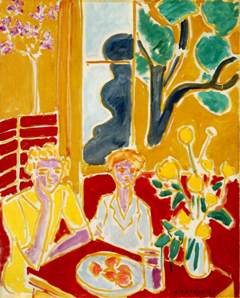
Deux fillettes, fond jaune et rouge (1947), oil on canvas, 61 x 49.8 cm is a painting by Henri Matisse in the collection of the Barnes Foundation, Merion, Pennsylvania.
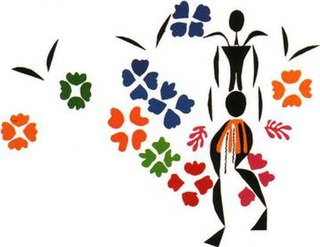
La Négresse (1952–53) by Henri Matisse is a gouache découpée, made of cut pieces of colored paper.
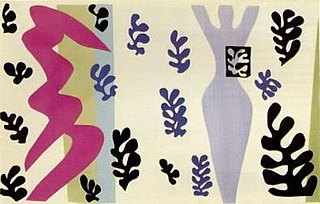
The Knife Thrower is a paper cut by Henri Matisse from 1947. It is from Jazz, 1947. It is held in the Menil Collection, in Houston.

Annelies, White Tulips and Anemones is a painting by Henri Matisse from 1944.

The Snail(L'escargot) is a collage by Henri Matisse. The work was created from summer 1952 to early 1953. It is pigmented with gouache on paper, cut and pasted onto a base layer of white paper measuring 9'43⁄4" × 9' 5" (287 × 288 cm). The piece is in the Tate Modern collection in London.

The Sorrows of the King is a collage using cut out paper shapes by Henri Matisse from 1952. It was made from paper he had coloured with gouache paint and is mounted on canvas. Its area is 292 x 386 cm. It was his final self-portrait. During the early-to-mid-1940s Matisse was in poor health. By 1950 he stopped painting in favor of his paper cutouts. The Sorrows of the King is an example of Matisse's final body of works known as the cutouts.

Woman In A Purple Coat or The Purple Coat is a painting by Henri Matisse from 1937. It depicts Matisse's assistant Lydia Delectorskaya. This painting is an example of Henri Matisse's mature decorative style. Matisse depicts his model and companion of many years, Lydia Delectorskaya, in an exotic Moroccan clothing, surrounded by a complex of abstract design and exotic color. This is an example of one of the final groups of oil paintings in Matisse's career, in 1950 he stopped painting oil paintings in favor of creating paper cutouts.

The Matisse Museum is a museum in Le Cateau-Cambrésis, France that primarily displays paintings by Henri Matisse. The museum was established by Matisse himself on 8 November 1952; he also defined the way his works should be arranged. At that time the museum was located in the wedding room of the Le Cateau City Hall.
Lydia Nikolaevna Délectorskaya was a Russian refugee and model best known for her collaboration with Henri Matisse from 1932 onwards.
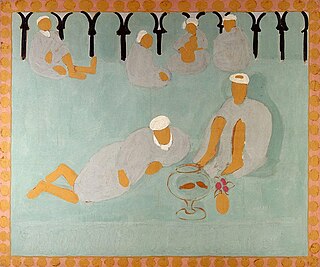
Arab Coffeehouse, is an oil-on-canvas painting by French visual artist Henri Matisse. Produced in 1913, Arab Coffeehouse was part of a series of goldfish paintings that Matisse produced in the 1910s and 1920s.


















